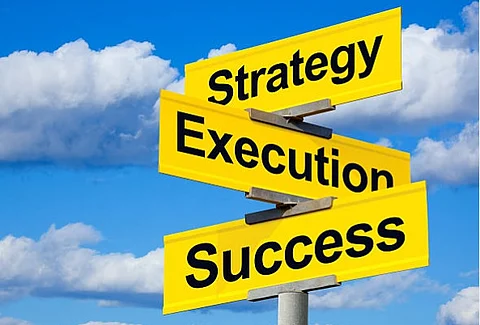

The word strategy makes us conjure up images such as – Napoleon Bonaparte, Admiral Nelson, General Patton and even Alexander The Great or Maharana Pratap Singh. And rightly so because of the association of the word strategy to warfare for a long time.
In warfare strategy refers to the series of moves that a general makes army to do to gain an advantageous position – be it capturing a place of importance, or defending a place.
In Business however, strategy refers to those efforts that we focus on and deploy resources for, to achieve a goal or objective. The key words are – efforts, resources and goal or objective.
What is not clearly articulated in the definition above, but implied is the aspect of making decisions.
To state concisely, strategy is about the decisions a business leader makes that sets direction and pace at which the business will move towards the set objective.
Execution refers to the act of implementing the decisions made such as type of resources to be committed & the quality and timing of such resources and the ability to measure the progress and adjust the course periodically until the objective is realised.
Business is not a walk in the park. With Covid, prolonged Ukraine – Russia hostilities, semiconductor shortages, high inflation in many western countries, and various geo political posturing in the backdrop of the accelerating global warming and rapid electrification of mobility the the business environment is volatile, uncertain, complex and ambiguous with business leaders getting brittle by the day, anxious about the non-linear evolution of the business environment and they start to feel that the world is more and incomprehensible.
Given this background, business leaders struggle with the classical definition of strategy and more importantly in executing any strategy.
Let me explain this through a familiar domain which is increasingly becoming incomprehensible.
If I am a business leader running an enterprise that serves the automobile industry from the vehicle manufacturers to the users of the vehicles, I am baffled by multiple developments happening at the same time – internal combustion engines are seemingly going away giving way to electric power trains in automobiles and the customer preferences shifting from owning a car to hailing a cab.
The strategic decisions staring at me everyday are – how much of capital investments I make now should support ICE vehicles and how much should be directed to EV related technologies?
Layered on top are the scarcity of lithium and semiconductor shortages. These confound the scenario. Next important decision is what resources should I invest in for future. Not knowing if fossil fuels will continue for a decade or more; or hydrogen will gain importance or lithium or any other material power the vehicles, I would be treading the thin ice the brittle technology landscape.
If global warming indeed forces the hands of regulators and mass public transit system gains more than automobiles, what investments should I make?
We are living in interesting times and the past is no guide to the future. There is a dire need to be nimble footed and agile to navigate through the ever changing landscape of business.
How can a CXO navigate this?
What is seemingly working for me are:
Being an agile learner – this means constantly looking at the marketplace for understanding how customer preferences are changing and how vendor priorities are changing; and accepting change ahead and working with these stakeholders and co-creating a solution. Personally for a CXO it requires the humility to say “I don’t know; let’s learn together”
Reduce the planning horizon and keep it telescopic – this means constantly scanning the environment to see what is likely to change faster and what is likely to remain unchanged for at least the next one year and deploy the most important resources – time and personal energy in prioritising the urgent and important and then the important.
Remain curious and avoid the trap of “I have 35 years of experience”. Instead start the self talk of everyday is my first day.
Remain humble and seek to learn from everybody who may have something working well for them in rapidly changing environment. There are no set industry boundaries anymore.
Improve personal resilience, as there is no option but to bounce back every time we fall. A leader’s resilience makes the organization more resilient.
Let’s anticipate change; let’s learn to learn.
Author's Background
Raghavan is currently President of Lucas Indian Service Limited, an Aftermarket Solutions company from the Lucas TVS group.
A Mechanical engineer from the College of Engineering, Guindy, Chennai (1983-87), Raghavan is also an alumnus of Great Lakes (PGXPM 2014-16) and a Certified Executive Coach from the Coaching Foundation of India (2012-13), & a Certified Independent Director (2020).
Raghavan has been working in private and public sector companies across multiple industries, including - Oil & Gas, Automotive Components, Industrial consumables and Capital Equipment, in multiple geographies, including South East Asia, Africa, China, the Middle East, Europe, and India.
Raghavan is a practitioner of Total Quality Management focusing on People Development, Process Improvements, and Excellence in Execution. He has been handling P&L roles for over 20 years and has handled the turnaround of businesses.
Raghavan is a firm believer in technology being the transformational and equalizing tool that can help transform businesses into more agile and customer-focused ones. He is currently working on the Digital Transformation of a few businesses.
Raghavan lives in Chennai with his family and is an avid reader.
